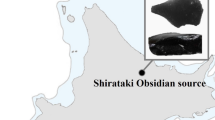Abstract
Heulandites from Rudno (Poland) and from Val Fassa (Italy) were studied by Mössbauer spectroscopy method. It was shown that iron can exist in different forms: as a magnetically, diluted hematite or as ions built into the framework of a zeolite or bound in its channels.
Similar content being viewed by others
References
J.A. Morice and L.V.C. Rees, Trans. Faraday Soc. 64 (1968) 1388.
E. Piekarska i A. Gaweł, Rocz. PTG 22 (1952) 353.
W. Kündig, H. Bömmel, G. Constabaris and R.H. Lindquist, Phys. Rev. 142 (1966) 327.
C. Janot et H. Gibert, Bull. Soc. fr. Mineral. Cristallogr. 93 (1970) 213.
J.K. Srivastava and R.P. Sharma, Phys. Stat. Sol. /b/ 49 (1972) 135.
E. De Grave, L.H. Bowen and S.B. Weed, J. Magn. Mat. 27 (1982) 98.
Author information
Authors and Affiliations
Rights and permissions
About this article
Cite this article
Kraczka, J., Kulgawczuk, D.S., Hrynkiewicz, A.Z. et al. Mössbauer study of naturally occurring heulandites. Hyperfine Interact 29, 1129–1132 (1986). https://doi.org/10.1007/BF02399433
Issue Date:
DOI: https://doi.org/10.1007/BF02399433




